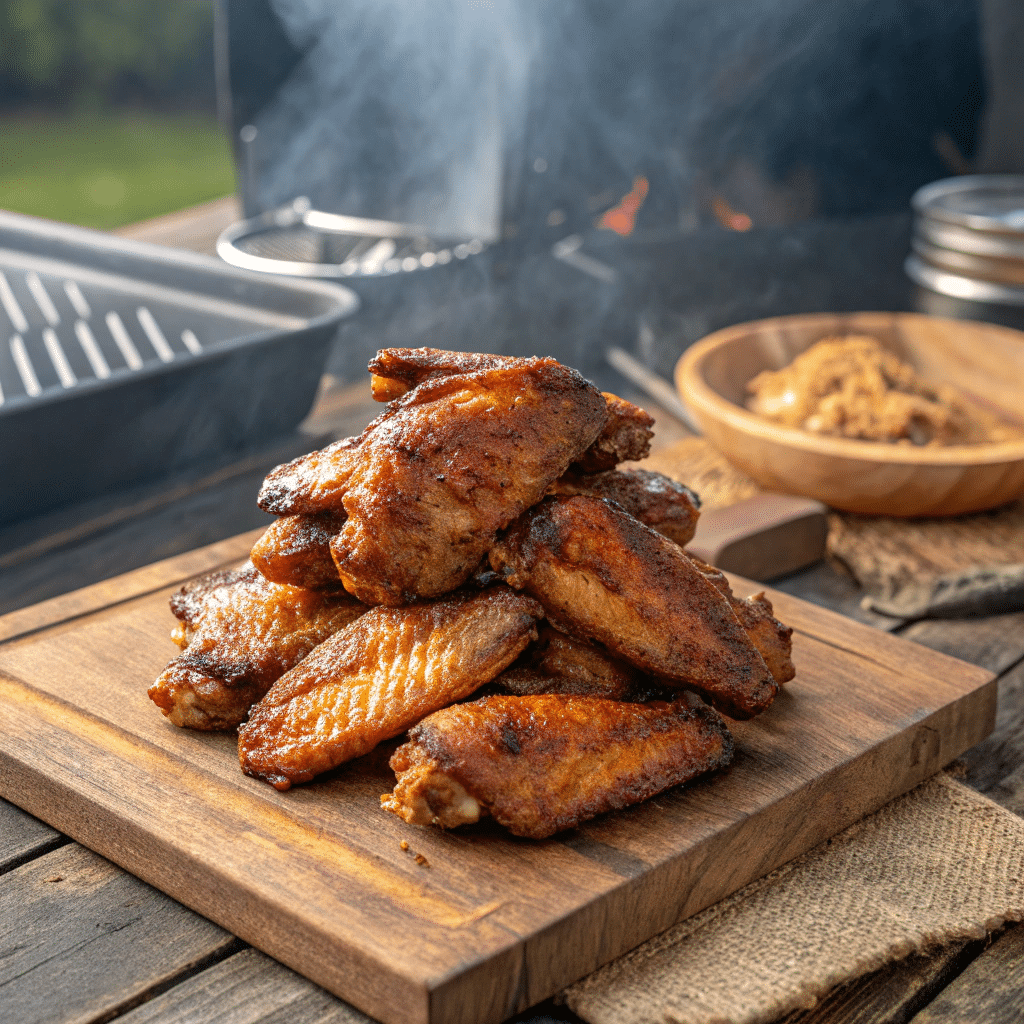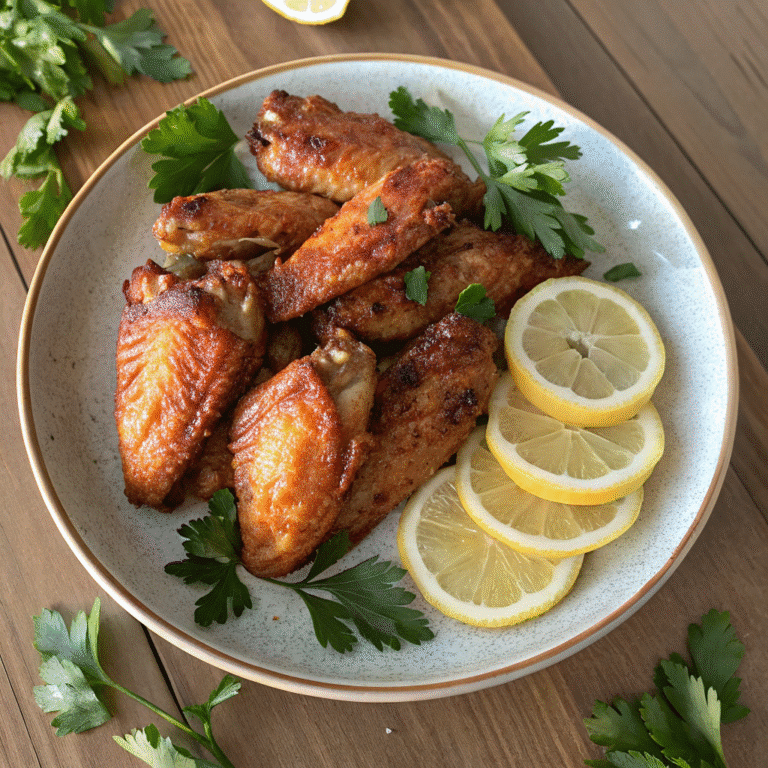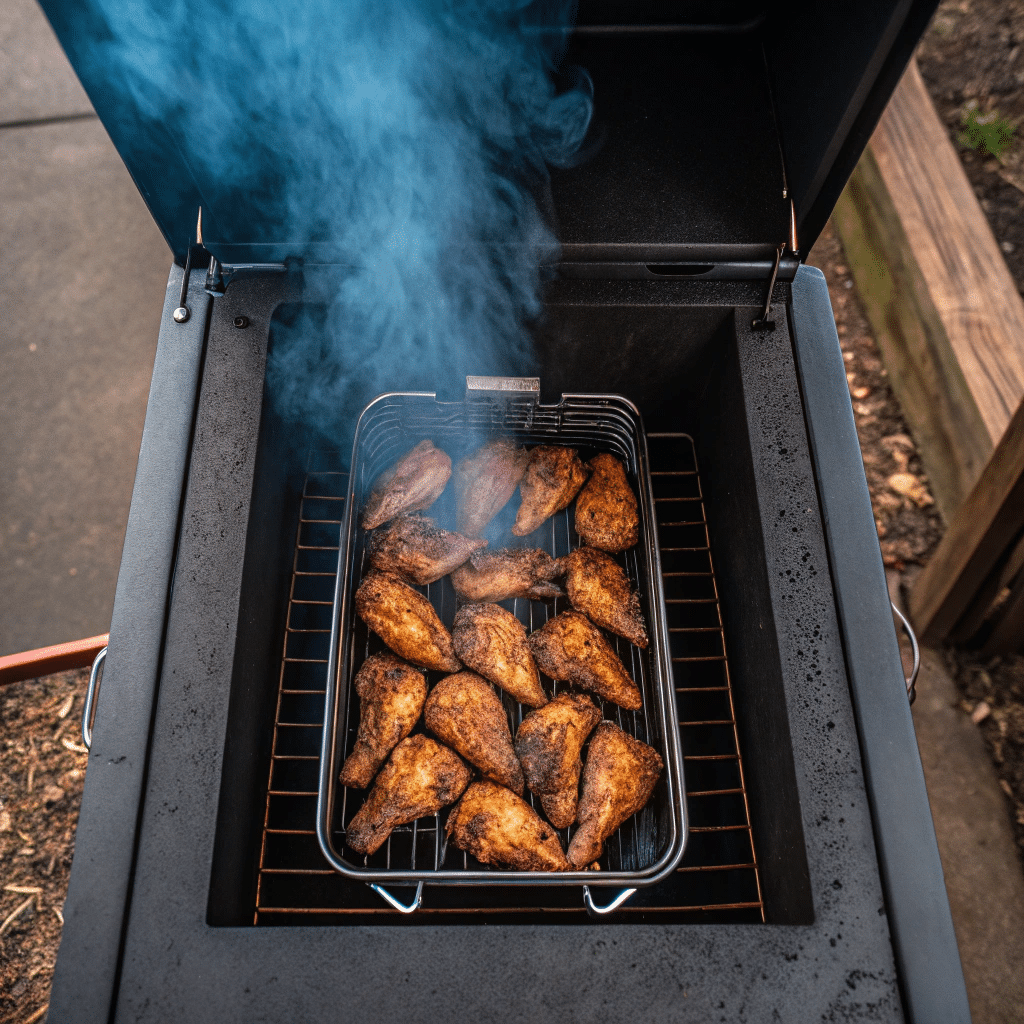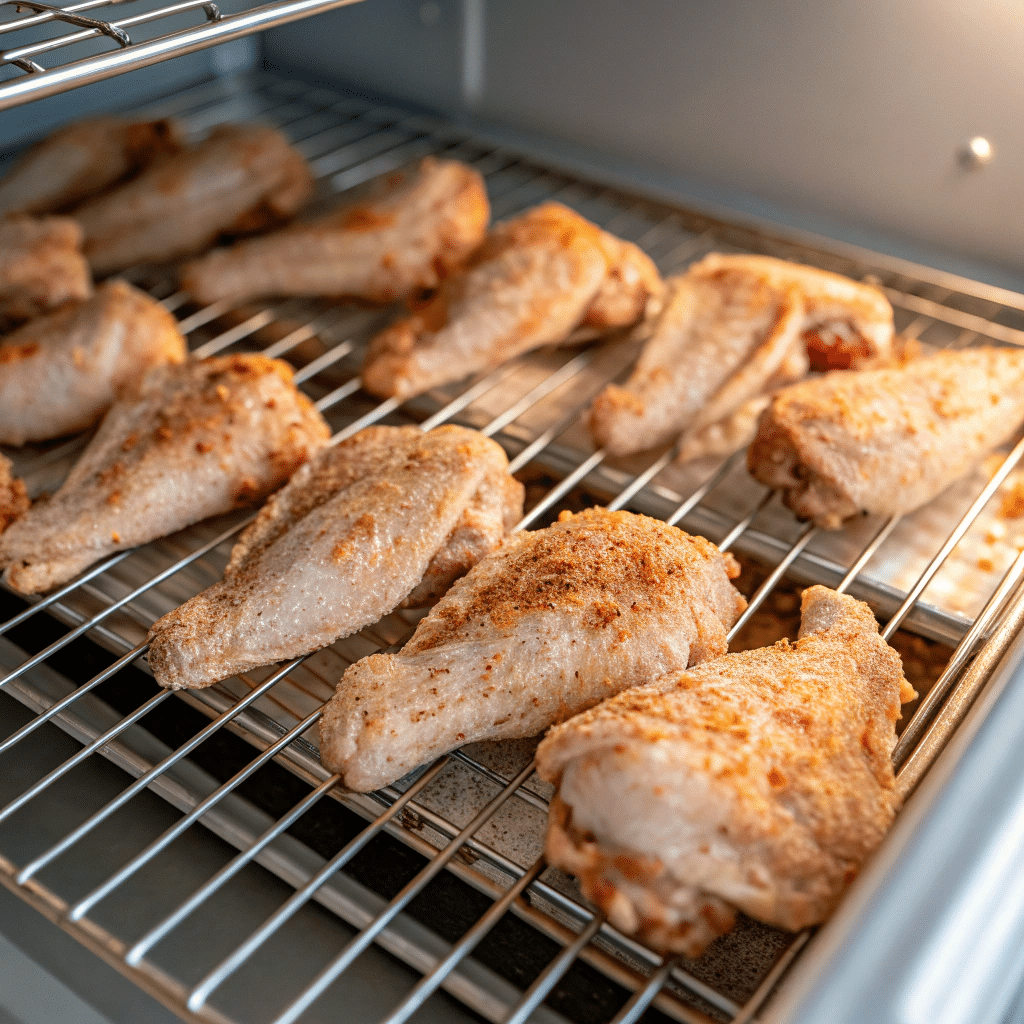If you’re anything like me, you know there’s nothing quite like biting into a perfectly cooked wing—especially when it’s packed with smoky flavor and that irresistible crispy skin. I’ve spent years testing different methods, and I can confidently say that crispy smoked chicken wings are the ultimate BBQ crowd-pleaser.

The combination of bold, smoky flavor and that perfect crunch is something I crave often—it’s truly one-of-a-kind. Whether you’re throwing a backyard cookout or hosting game day at home, crispy smoked chicken wings always steal the show. And here’s the best part—they’re easier to make than most people think.
In this guide, I’ll walk you through everything you need to know—from choosing the right wings and gear to my signature rubs, preferred wood types, and ideal smoker settings. I’ll show you how to master the entire process, step by step.
Print
Crispy Smoked Chicken Wings
These crispy smoked chicken wings are packed with smoky flavor and finished to golden perfection. The dry brine and baking powder rub help create thin, crackly skin with juicy meat inside—ideal for game day, cookouts, or BBQ nights.
- Total Time: 9 hours 25 minutes
- Yield: 4 servings 1x
Ingredients
2 lbs chicken wings (split, tips removed)
2 tbsp kosher salt (for dry brine)
1 tbsp baking powder
1 tbsp smoked paprika
1 tsp garlic powder
1 tsp onion powder
½ tsp black pepper
Optional: lemon wedges and parsley for garnish
Instructions
Dry Brine:
Pat wings dry with paper towels. Sprinkle evenly with kosher salt. Place on a wire rack over a tray and refrigerate uncovered overnight (at least 8 hours).Preheat Smoker:
Set your smoker to 225°F using dry hickory or applewood chips.Apply Rub:
Mix baking powder, smoked paprika, garlic powder, onion powder, and black pepper. Coat wings evenly.Smoke the Wings:
Place wings in smoker, spaced apart. Smoke for 1 hour at 225°F.Crisp Finish:
Increase heat to 375°F and cook for 10–15 more minutes until the skin becomes golden and crispy.
Rest & Serve:
Remove wings, let rest for 5 minutes, then serve with lemon wedges and fresh parsley.
Notes
Avoid sugary sauces before smoking to prevent soggy skin.
You can finish the wings in the oven or on a grill if your smoker doesn’t hit high temps.
Add a light sauce after resting if desired—don’t drown the wings while they’re hot.
- Prep Time: 10 minutes + 8 hours dry brine
- Cook Time: 1 hours 15 minutes
- Category: Appetizer, Main Dish
- Method: Smoking + High Heat Finish
- Cuisine: American BBQ
- Diet: Gluten Free
Nutrition
- Calories: 280 kcal
- Sodium: 620mg
- Fat: 18g
- Saturated Fat: 5g
- Unsaturated Fat: 12g
- Carbohydrates: 2g
- Protein: 22g
- Cholesterol: 95mg
Sometimes I like to mix wood types depending on my flavor goal. For example, if I’m preparing a weekend spread with sides or even turkey wings done right, I’ll blend cherry and hickory to match intensity across the meal.
Table of Contents
Why Crispy Smoked Chicken Wings Are a Game-Changer
The Rise of Smoked Wings in BBQ Culture
Let me start by saying it—crispy smoked chicken wings are taking over backyard cookouts, and honestly, I’m here for it. We’ve all had fried wings: crunchy, sure, but often greasy and heavy. When I first tried smoking wings and getting that same crisp—without deep-frying—I was blown away. It didn’t just taste better, it felt better.
This shift from fried to smoked isn’t just a trend; it’s a flavor revolution. Crispy smoked chicken wings deliver that bold, smoky richness we all love, with skin that crackles when you bite into it. And when you make them right, you don’t lose that crisp after five minutes on the plate.
What I love most is the balance. You get all that deep smoke flavor, and the wings still stay light, clean, and loaded with texture. No oil splatters. No fryer smells. Just pure, addictive perfection.
What Makes a Chicken Wing “Crispy” When Smoked?
Here’s what I learned early on: crispy smoked chicken wings are all about controlling fat and moisture. You don’t want soggy skin—ever. That starts before the wings even hit the smoker. I always pat them dry, sometimes even let them air-chill in the fridge overnight. That alone changes everything.
The skin turns perfectly crisp as the fat beneath it slowly melts away. Then, a flash of high heat seals the deal. Whether I finish them on a hot grill, under the broiler, or crank up the smoker at the end—boom, that’s where the magic happens.
And don’t overlook just how transformative a good dry rub can be. A good one doesn’t just flavor the meat—it draws out moisture and helps that crispy finish we’re chasing.
If you’ve ever wondered whether smoke and crunch can coexist, I’m here to tell you: crispy smoked chicken wings prove they absolutely can.
Choosing the Right Chicken Wings for Smoking
Whole vs. Split Wings: What Works Best for Crispiness?
When I first started making crispy smoked chicken wings, I thought any wing would do. But after testing dozens of batches, I’ve learned that the cut really does matter. Whole wings look cool and rustic, but they don’t cook as evenly. The drumette, flat, and tip each react to heat in their own way, making it tricky to get that perfectly even crispness.
Personally, I go for split wings. They cook faster, crisp up better, and soak up smoke more evenly. Plus, they’re easier to serve at parties or game day spreads. Less fuss, better crunch.
If you go with whole wings, be sure to trim off the wing tip—it doesn’t contribute much and can interfere with achieving that ideal texture we’re after.
Best Meat Quality and Cuts for Smoking Chicken Wings
Quality really does make a difference when it comes to smoking. I always start with fresh, never frozen, chicken wings if I can find them. Frozen ones can hold onto water, and too much moisture is the enemy of crispy skin.
Look for wings with a nice, firm feel and pale skin. Organic or pasture-raised wings tend to render better fat and hold up well to long smoking sessions. They also have better natural flavor, which means you don’t need to drown them in rubs or sauces.
Bottom line: starting with the right cut and quality of chicken gives you a solid foundation for making crispy smoked wings that truly set themselves apart. It’s the first step in getting that skin to snap when you bite in—and trust me, your guests will notice.
Essential Equipment for Smoking Chicken Wings to Perfection
Smoker Types: Pellet, Offset, or Electric – Which Delivers the Best Texture?
Getting crispy smoked chicken wings just right doesn’t happen by accident—it starts with the right smoker. I’ve experimented with nearly every type out there, from high-end pellet grills to old-school offset smokers and plug-and-play electric models.
Pellet smokers are my top pick for ease and consistency. They let you control the temperature precisely, which helps when you want evenly rendered fat and crisp skin. Offset smokers? They’re a bit more work, but the deep smoke flavor you get is hard to beat.

Electric smokers can handle the job, but I’ve found they don’t always create the airflow or dryness needed for that signature crunch. That’s why I always build in a hot-finish step—either cranking up the heat or searing the wings on a hot grill.
Must-Have Tools: Thermometers, Racks & Wood Chips
The right accessories can seriously level up your smoked wing game. A good digital thermometer is essential to track internal temps—you’re aiming for around 175°F, the sweet spot where the skin firms up but the meat stays juicy.
I always use a raised wire rack when making crispy smoked chicken wings—it’s a key step that sets my method apart. It keeps the wings lifted so air can circulate underneath, drying the skin more effectively.
And don’t overlook wood selection. I love combining applewood and hickory for balanced flavor that enhances the rub without softening the crisp. Every tool and tweak counts when your goal is to serve up crispy smoked chicken wings that leave people coming back for more.
The Science Behind Crispy Skin on Smoked Wings
Why Skin Gets Soggy and How to Prevent It
When I first started smoking wings, I couldn’t figure out why the skin kept turning out rubbery—it was a frustrating mystery at first. The flavor was there, but the texture? Not so much. What I eventually learned is that smoke alone doesn’t create crispiness—in fact, the moisture it produces can do the opposite.
To get truly crispy smoked chicken wings, you’ve got to remove as much surface moisture as possible before the wings even hit the smoker. I always pat them dry and let them sit uncovered in the fridge overnight. This process, known as air-drying, helps dehydrate the skin so it tightens up during cooking.
Another mistake I made early on? Smoking at too low a temperature. While low and slow gives amazing flavor, it doesn’t render the fat under the skin effectively. If the fat doesn’t render, the skin won’t crisp. Period.
How Low-and-Slow Cooking Affects Wing Texture
Smoking wings at a lower temp (say, 225°F) allows smoke to infuse deeply, but you’ll need to finish them with high heat to crisp up the skin. I usually bump the heat to 375°F for the last 10–15 minutes. That final blast helps shrink the skin and dry it out for that crackling finish.
There’s a science to crispy smoked chicken wings, and it’s all about balancing moisture, fat, and heat. Once I figured that out, everything changed. Now I get tender meat inside, and outside? That bite-through crunch everyone talks about.
Nail the prep, the temperature, and the finish—and you’re well on your way to smoked wing perfection.
Preparing Wings Before They Hit the Smoker
Dry Brining vs. Wet Brining: Which Helps with Crisp?
When I started experimenting with smoked wings, I underestimated how important prep is—especially if your goal is crispy smoked chicken wings. It all starts before the smoker is even on.
My top method is dry brining. I coat the wings with kosher salt and refrigerate them uncovered overnight. That step draws out moisture from the skin, allowing it to firm up and crisp beautifully during the smoke. It’s a simple step, but it changes everything.

Wet brining, while useful for juiciness, tends to leave extra moisture on the surface. And as we all know, moisture is the enemy of crisp skin. For consistently great texture, I always go with a dry brine.
Secret Rubs and Marinades That Boost Texture & Flavor
After brining, I move on to the rub. A dry mix with garlic powder, onion powder, smoked paprika, and a small amount of baking powder does wonders. Baking powder raises the skin’s pH, which encourages better browning and crisping in the smoker.
I steer clear of sticky or sugary marinades before cooking. They can prevent proper drying and make the skin soft instead of crisp.
Getting crispy smoked chicken wings is all about thoughtful prep. When you dry brine and use the right rub, you set yourself up for wings that deliver both bold flavor and the crunch that keeps people coming back for more.
If you get this part right, your crispy smoked chicken wings will stand out every time. It’s the prep that sets the stage for texture and flavor you can’t fake
Smoking Techniques for Crispy Chicken Wings
Temperature Ranges for Smoking vs. Finishing Crisp
One of the biggest lessons I’ve learned in my BBQ journey is this: smoking and crisping are two different stages. If you want perfect crispy smoked chicken wings, you need to understand how to balance low-and-slow heat with a high-heat finish.
I typically start by smoking wings at 225°F–250°F. This low temperature allows the meat to absorb all that smoky flavor while staying juicy. But if you stop there, the skin will come out rubbery—not crispy. That’s where the second stage comes in.
To finish, I crank the heat up to 375°F or even 400°F for the final 10–15 minutes. That burst of high heat helps dry and tighten the skin, giving it the bite-through texture you’re aiming for. Whether I finish them in the smoker, on a hot grill, or under the broiler, that last step is where the magic happens.
How to Reverse Sear or Flash Crisp in the Smoker or Oven
Reverse searing has become one of my go-to techniques. After smoking the wings low and slow, I let them rest for a few minutes, then finish them with direct high heat. If I’m already outside, I’ll toss them on a hot grill grate for a quick sear. If I’m inside, I’ll throw them under the broiler for 3–5 minutes.
Some smokers can reach high enough temps to do it all in one place. If yours can hit 375°F+, you’re in luck. Just bump the temp at the end and rotate the wings to crisp them evenly.
This combo approach—smoke for flavor, high heat for crunch—is how I consistently get crispy smoked chicken wings that are juicy inside and crackly on the outside.It’s how I consistently turn out crispy smoked chicken wings that deliver both taste and texture in every bite.
Flavorful Wood Combinations That Don’t Compromise the Crunch
Top Wood Types for Smoked Wings (Hickory, Applewood, etc.)
When I first started crispy smoked chicken wings, I focused on flavor, not texture. But as I refined my method for crispy smoked chicken wings, I realized the type of wood you use plays a huge role—not just in flavor, but in moisture control.
Hickory is my go-to for bold, savory wings. It delivers a bold smokiness that complements the rub rather than overwhelming it. When I’m aiming for a hint of sweetness, I’ll blend in some applewood. That combo gives a smooth, well-balanced flavor profile that doesn’t compete with the crispy skin.
Oak is another solid option. It burns clean and hot, which helps maintain the steady temperature needed for consistent results. Mesquite? I use it sparingly—it can be a little intense for smaller cuts like wings.
The key is using wood that complements your dry rub and doesn’t introduce too much moisture into the cooking chamber.
How Smoke Type Affects Skin Texture
Believe it or not, the type and amount of smoke can actually impact skin texture. Thick, moisture-laden smoke—typically from damp wood chips or unseasoned wood—can leave the skin with a tough, rubbery texture. I always use dry, seasoned wood for a clean-burning fire that lets the wings crisp instead of steam.
If you’re chasing that thin, snappy skin, keep your smoke light and consistent. Too much smoke can coat the surface and trap moisture. I’ve found that less is more when the goal is texture and not just taste.
Nailing the perfect wood-to-technique combo is my secret to consistently turning out crispy smoked chicken wings with crackling skin, bold flavor, and a deep, smoky finish that checks every box
Serving Your Crispy Smoked Chicken Wings Like a Pro
Best Sauces That Maintain Crunch (Not Make It Soggy)
When it comes to serving, the biggest mistake I used to make was drowning wings in sauce right out of the smoker. That’s a fast way to undo all the work it took to get crispy smoked chicken wings. The key is balance—sauce should enhance the wings, not soak them.
I always let the wings rest for a few minutes before tossing them in a light layer of sauce. If I’m using something sticky like BBQ or buffalo, I warm it up first so it goes on smoother and doesn’t shock the hot skin. Better yet, I often serve the sauce on the side, especially if I’m hosting a crowd. That way, everyone gets wings the way they like—crispy, tangy, or somewhere in between.
Dry wings also shine when paired with a dipping sauce—think ranch, blue cheese, or honey mustard. Just make sure you’re not using something that softens the crisp skin.
Plating, Pairing, and Garnishing Ideas for Parties & BBQs
Presentation matters more than most people think. I like to pile wings high on a rustic wooden board with fresh herbs scattered around—parsley or green onion works great. Brighten things up with lemon wedges or crisp celery slices—they add a pop of color and a refreshing bite.
Pairing is simple. I usually go with cold beer, sweet tea, or even sparkling water with lime. For sides, I like to add some crunch—think tangy coleslaw, zesty pickled veggies, or smoky grilled corn to round out the plate.
However you choose to serve them, crispy smoked chicken wings deserve a stage. With the right sauce strategy and a bit of presentation flair, you’ll turn a casual BBQ dish into something people rave about.
Common Mistakes to Avoid When Smoking Chicken Wings
Why Wings End Up Rubbery or Mushy – and How to Fix It
Back when I started smoking wings, I had my fair share of disappointments—especially when they came out soft or rubbery. After a lot of trial and error, I figured out that avoiding a few key mistakes makes all the difference, especially when you’re aiming for crispy smoked chicken wings.
The most common mistake? Starting with wet wings. If the skin isn’t dry before smoking, the moisture will prevent it from crisping. That’s why I always pat them dry and let them air out in the fridge, uncovered, overnight.
Another issue is crowding the smoker. Wings need airflow to crisp properly. Cramming too many on the rack traps steam, and you’ll end up with a soggy batch. Give them space and rotate if needed.
Low temperature without a finish is another big one. You need to smoke low for flavor, but finish hot to render fat and tighten the skin. Skipping that step ruins your chance at true texture.
Avoid These Temperature and Timing Errors
Timing by the clock instead of temperature? Been there. I always use a digital thermometer now. Wings are best cooked to 175°F–180°F—just right to melt the fat without drying out the juicy meat.
Don’t open the lid too much either. Each time you lift the lid, you let heat out and add more time to the cook.
Once I nailed these basics, I started getting consistent results. My crispy smoked chicken wings were no longer hit-or-miss—they were perfectly cooked every time. Success comes from steering clear of these mistakes and having faith in the process.
When you master technique and timing, you’re rewarded with crispy smoked chicken wings that deliver big flavor, juicy meat, and skin that crunches just right.
Frequently Asked Questions About Crispy Smoked Chicken Wings
1. How do you get crispy skin when smoking wings?
From my experience, the secret to crispy skin lies in the prep. First, pat the wings completely dry and air-chill them in the fridge overnight. That step removes surface moisture and sets the stage for crunch. Then, during the cook, smoke low and finish hot. This combo renders the fat and tightens the skin. If you’re after crispy smoked chicken wings, this technique is non-negotiable.
2. How do you get crispy skin on a smoked chicken?
The principles are the same whether you’re cooking wings or a whole bird. I apply baking powder to my dry rub—it raises the skin’s pH, helping it brown faster. I also finish my smoked chicken at a higher heat (around 375°F) to really crisp things up. For wings, I find this method delivers even better results. That’s why I keep going back to crispy smoked chicken wings every weekend.
3. What is the secret ingredient to crispy wings?
I’ll let you in on mine: baking powder. It’s the underrated MVP in most of my rubs. It helps dry out the skin and promotes browning. Combined with dry brining and a hot finish, it’s essential for crispy smoked chicken wings. Just be sure not to overdo it—too much can affect the taste.
4. How do you get really crispy chicken wings?
It’s all about method. Dry brine, air dry, apply a baking powder rub, smoke low, and finish with high heat. Follow these steps, and you’ll nail that perfect texture. I’ve used this system for years, and it’s how I’ve perfected my crispy smoked chicken wings recipe. The crunch is real—and it’s repeatable.
